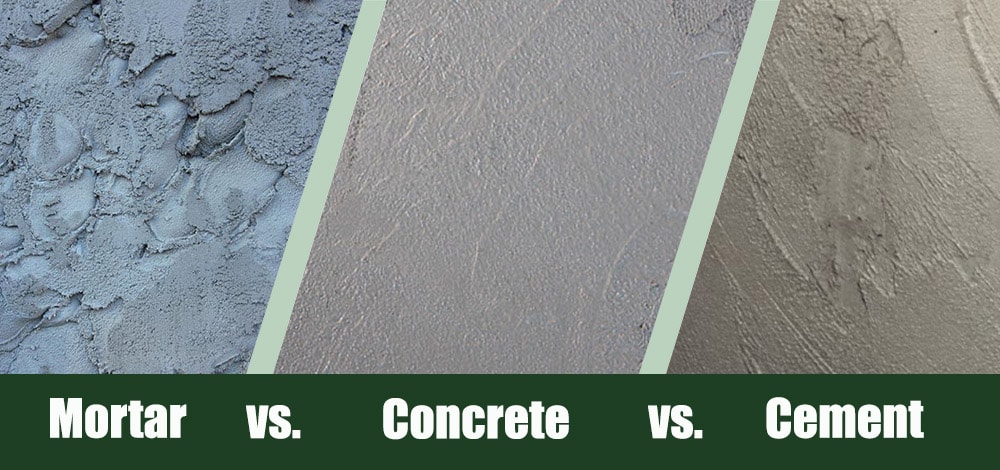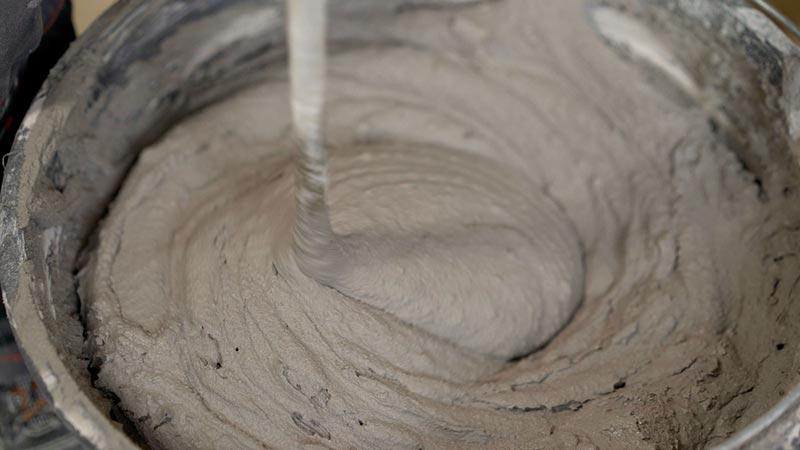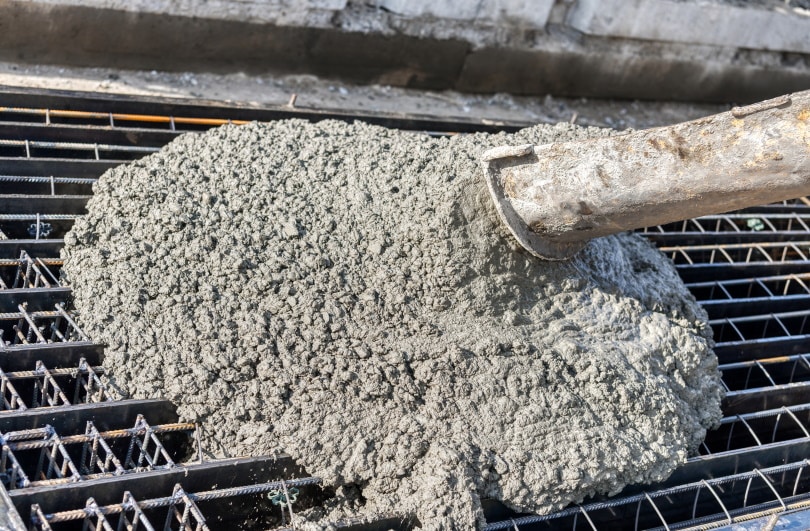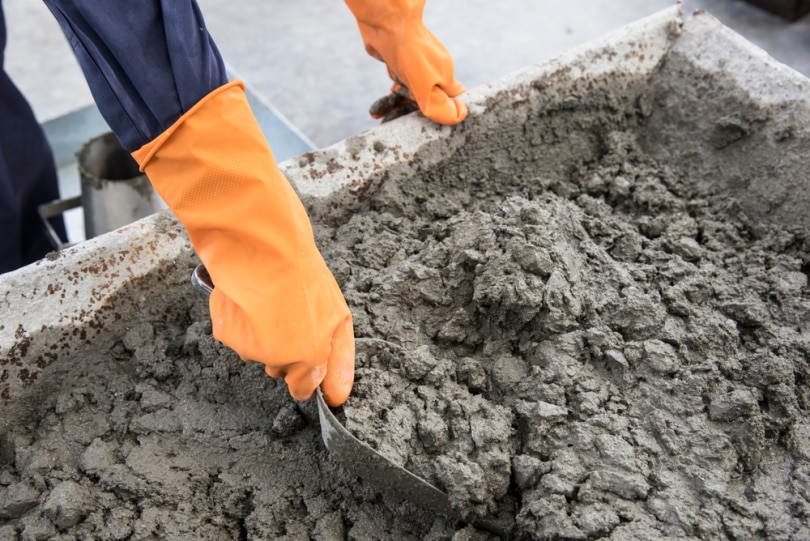Mortar vs. Concrete vs. Cement: Pros, Cons, & Differences
-

- Last updated:

Mortar, concrete, and cement are common building components. Many people run into these terms all the time. Whether you are building a house or just putting in a fence, you are likely to encounter these building materials. There is a lot of confusion around what exactly mortar, concrete, and cement actually are. Some people think that these three materials are the same, or similar enough to be indistinguishable from one another. But they are not indistinguishable. They are very different and misusing these three terms can be detrimental to your building project.
Here is a quick overview of mortar, concrete, and cement, including the main differences, pros, and cons of each, and the common uses for all three.

Overview of Mortar

Mortar is a mixture that is used to join or glue two masonry materials together. Mortar is made up of Portland cement, fine sand, lime, and water. Without the water, mortar is a powdery mixture, which needs the water to activate it. Activating the mortar allows it to be used to join two pieces of masonry, such as bricks or cinder blocks, together. Mortar is not as strong as concrete but includes cement as one of its primary components.
Mortar has multiple different configurations that include grout and thin-set. Grout is mortar without lime and is used to fill gaps between tiles. Thin-set, similarly, is also used on tile to bond it to an underlayment. Thin-set includes cement and very fine sand, as well as some synthetic additives that help form a stronger adhesive bond.
You can create your own mortar mixture by buying Portland cement and fine sand and mixing them together with water. Most people buy pre-mixed bags at their local store.
Primary Uses of Mortar
The primary use of mortar is to join multiple masonry components together. Mortar is featured in a variety of different applications. Cinder block walls are fused together with mortar. Bricks are also joined together using mortar. Brick construction includes things like retaining walls, fireplaces, and fire pits. All of these structures are joined together with mortar to keep them strong.
Without mortar, these things would simply be piles of rocks or bricks without any structural integrity. Mortar is a critical component of all masonry construction. Without it, you could simply push over the stacks of blocks and bricks.
What Makes Mortar Different?
Mortar is different from concrete and cement in a few ways. First, mortar contains cement and sand. Concrete includes cement and larger additives called aggregates. Mortar additives are much finer than concrete aggregates. That makes mortar easier to spread, but it also makes the final product weaker than concrete. Mortar retains much more air and water than concrete which makes it lighter and easier to work with.
- Easy to spread
- Vital part of masonry construction
- Can be mixed on your own if you need to
- Not as strong as concrete
- See also: 7 Types of Mortar & Their Different Uses

Overview of Concrete

Concrete is a mixture of Portland cement, coarse sand, small gravel, and water. Without water, concrete is a dry mixture that comes in bags. Concrete is stronger than mortar and is used to create structural forms. Concrete is used to create slabs, walls, and footers. These applications require more strength than mortar can provide. Concrete is used in all sorts of ways, from art to home foundations and large retaining walls. In order to get the structural integrity needed to meet building codes, concrete usually contains rebar or metal mesh to improve strength and durability.
Concrete is most often bought in pre-mixed bags that are activated with water, but you can also buy concrete in liquid form from a concrete company that will come and pour the concrete for you on site. When concrete dries, it becomes very hard.
Primary Uses of Concrete
Concrete is primarily used for structural building. Concrete’s strength and versatility make it ideal for large retaining walls, columns, slabs, footers, and more. Concrete can be used in small jobs, like stabilizing a fence post in the ground, or large jobs, like skyscrapers. Since concrete can be poured into a variety of different molds, it is also used to create shapes like spheres or as a base for certain types of artwork, such as sculptures.
Concrete can also be used for solid surfaces like a tennis court or racquetball court, as well as exposed slabs for things like sheds and pole barns. You can also leave residential slabs exposed and polish them to create a type of modern flooring.
What Makes Concrete Different
Concrete differs from mortar in that it contains larger and coarser aggregates. Mortar is made up of very fine additives, while concrete has much larger additives. Large scale concrete is mixed with gravel and poured directly into its final destination using large trucks. Mortar is never used in large scale or thick applications like concrete. Concrete is used in conjunction with mesh and rebar. Mortar never uses rebar or mesh for additional strength.
- Very strong
- Easy to obtain
- Versatile uses
- Harder to form and spread than mortar

Overview of Cement

Cement is the primary ingredient of both mortar and concrete. Concrete is never used by itself. Pure concrete is a very fine powder that is used to create strong mixtures. There are very few uses for pure cement. Cement, instead, is used to create mixtures of mortar and concrete using things like sand, gravel, rock, lime, and more. The most common version of modern cement is Portland cement. Portland cement can be bought on its own, but it is always purchased in order to create something else. On its own, cement has very little strength and cannot be used in the same way as mortar and concrete.
Pure cement makes up between 10% and 20% of concrete’s total volume.
Cement is created by mining materials like clay, shale, and limestone. These materials are then crushed into a very fine powder and fired in a giant kiln. The heat from the kiln burns away impurities and leaves an extremely fine powder behind that becomes Portland cement.
The formula can be tweaked to create a variety of different grades of cement. There are eight different varieties of cement.
- Type I
- Type II
- Type II (MH)
- Type III
- Type IV
- Type V
- Type IA
- Type IIA
Most people simply use Type I, but the rest of these formulas can be used in different types of mixtures by manufacturers and engineers for different purposes.
Primary Uses of Cement
Cement is used as an additive to create other materials. Cement is used to create concrete, mortar, grout, thin-set, stucco, and more. Cement can be combined and mixed to create a variety of different materials. Cement is almost always used to create building materials.
What Makes Cement Different?
Cement is the primary ingredient of both mortar and concrete, but it is not the same as either. Cement is similar to flour in that flour is the base ingredient for most types of dough, but by itself, flour is not very tasty or usable. Like flour, cement has to be mixed with water and other components in order to make something better. Without additives, concrete is very fine, very weak, and has very few legitimate uses.
- Critical component in a variety of different materials
- Very versatile
- Can be mixed with a variety of different things to create new results
- Easy to mix with aggregates if necessary
- Very weak
- Cannot be used on its own
- Name can cause confusion with other building materials

FAQ
Are the Terms Concrete and Cement Interchangeable?
No, the terms concrete and cement are not interchangeable, even though many people use the words concrete and cement interchangeably. But they are very different materials. It’s important to learn the differences between concrete and cement and use the terms correctly to avoid any confusion or mistakes when using them for your projects.
Is Mortar, Concrete, or Cement Stronger?
Concrete is the strongest material out of the three. Mortar is the second strongest material, while pure cement is the weakest of the three. Cement is always used as an additive. You cannot use cement on its own because it needs other ingredients to obtain the strength that makes it usable. Mortar and concrete each have things that they do well and that they do the best. If you are looking for the highest-strength material, you should stick with concrete.
Can You Use Concrete Instead of Mortar?
In most cases, you should be able to use concrete instead of mortar. Concrete is like mortar but is stronger than mortar. If you need a material to help join or glue two pieces of building material together, you should be able to use mortar instead of concrete. However, it is always best to follow local codes or official instructions. If you have plans or instructions calling for mortar, you should use mortar instead of concrete for the best results.
Can You Use Mortar Instead of Concrete?
Mortar should primarily be used to fuse two types of building materials together. Generally, mortar is used to join two pieces of rock or brick together. Concrete is most often used in a structural setting. Mortar cannot be used as a structural material since it is much weaker than concrete. If you are using concrete to meld or glue things together, you can use mortar instead. However, if you are trying to use mortar for something structural, you should stick to concrete.
Quick Recap
- Brick fireplaces
- Fire pits
- Retaining walls made from individual masonry pieces
- Cinder block walls
- Backsplashes or tile
- Slabs or footers
- Large pillars or columns
- Sidewalks or other exposed surfaces
- Large-scale commercial construction
- Strong areas reinforced with rebar and mesh
- Mortar
- Concrete
- Stucco
- Thin-set
- Grout

Conclusion
Even though many people accidentally use the terms mortar, concrete, and cement interchangeably, they are all very different materials. The confusion arises from the fact that cement is a component of both concrete and mortar but is different from either. Do not use mortar, concrete, or cement interchangeably during building or in your conversations because it could create a lot of confusion and lead to poor outcomes.
Related Reads:
Featured Image Credit: Mortar – rkit, Pixabay | Concrete – fongbeerredhot, Shutterstock | Cement – lovelyday12, Shutterstock
Contents
